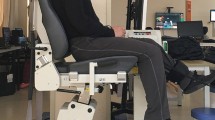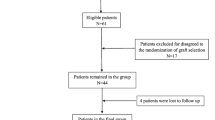Abstract
Anterior cruciate ligament (ACL) ruptures lead to a proprioceptive deficit and therefore joint position sense. This study examined whether active motion is better suited than passive motion to address this deficit. Sixty patients with ACL rupture were prospectively randomised into two groups [continuous active motion (CAM)/continuous passive motion (CPM)]. All patients had an ACL reconstruction. An angle reproduction test was used to assess the proprioceptive deficit. The relevant examinations were performed before surgery (pre-op evaluation) and after the seventh postoperative day. No preoperative difference was found between the two groups. After postoperative treatment, the deficit was reduced in both groups. Significantly better results were, however, obtained in the CAM group (CPM, 4.2±1.6°; CAM, 1.9±1.2°; P<0.001). During the first postoperative week, a CAM device produced a significantly greater reduction in the proprioceptive deficit and should be the first choice in immediately postoperative rehabilitation after ACL replacement.




Similar content being viewed by others
References
Banzer W, Neumann D (1995) Open and closed kinetic chain in rehabilitation after athletic injuries. Sportverletz Sportschaden 9:98
Barret DS, Cobb AG, Bently G (1991) Proprioception and function after anterior cruciate reconstruction. J Bone Joint Surg Br 73:833
Bartlett MJ, Warren PJ (2002) Effect of warming up on knee proprioception before sporting activity. Br J Sports Med 36:132
Borsa PA, Lephart SM, Irrgang JJ, Safran MR, Fu FH (1997) The effects of joint position and direction of joint motion on proprioceptive sensibility in anterior cruciate ligament-deficient athletes. Am J Sports Med 25:336
Bouet V, Gahery Y (2000) Muscular exercise improves knee position sense in humans. Neurosci Lett 289:143
Carter ND, Jenkinson TR, Wilson D, Jones DW, Torode AS (1997) Joint position sense and rehabilitation in the anterior cruciate ligament deficient knee. Br J Sports Med 31:209
Co FH, Skinner HB, Cannon WD (1993) Effect of reconstruction of the anterior cruciate ligament on proprioception of the knee and the heel strike transient. J Orthop Res 11:696
Dye SF, Vaupel GL, Dye CC (1998) Conscious neurosensory mapping of the internal structures of the human knee without intraarticular anesthesia. Am J Sports Med 26:773
Fitzgerald GK, Axe MJ, Snyder-Mackler L (2000) The efficacy of perturbation training in nonoperative anterior cruciate ligament rehabilitation programs for physical active individuals. Phys Ther 80:128
Fremerey RW, Lobenhoffer P, Born I, Tscherne H, Bosch U (1998) Can knee joint proprioception by reconstruction of the anterior cruciate ligament be restored? A prospective longitudinal study. Unfallchirurg 101:697
Friden T, Roberts D, Zatterstrom R, Lindstrand A, Moritz U (1996) Proprioception in the nearly extended knee. Measurements of position and movement in healthy individuals and in symptomatic anterior cruciate ligament injured patients. Knee Surg Sports Traumatol Arthrosc 4:217
Friden T, Roberts D, Zatterstrom R, Lindstrand A, Moritz U (1999) Proprioceptive defects after an anterior cruciate ligament rupture—the relation to associated anatomical lesions and subjective knee function. Knee Surg Sports Traumatol Arthrosc 73:226
Friden T, Roberts D, Ageberg E, Walden M, Zatterstrom R (2001) Review of knee proprioception and the relation to extremity function after an anterior cruciate ligament rupture. J Orthop Sports Phys Ther 31:567
Goertzen M, Gruber J, Dellmann A, Clahsen H, Schulitz KP (1992) Neurohistological findings after experimental anterior cruciate ligament allograft transplantation. Arch Orthop Trauma Surg 111:126
Good L, Roos H, Gottlieb DJ, Renstrom PA, Beynnon BD (1999) Joint position sense is not changed after acute disruption of the anterior cruciate ligament. Acta Orthop Scand 70:194
Halata Z, Wagner C, Baumann KI (1999) Sensory nerve endings in the anterior cruciate ligament (Lig. cruciatum anterius) of sheep. Anat Rec 254:13
Haus J, Halata Z, Refior HJ (1992) Proprioception in the anterior cruciate ligament of the human knee joint—morphological bases. A light, scanning and transmission electron microscopy study. Z Orthop Ihre Grenzgeb 130:484
Hewett TE, Paterno MV, Myer GD (2002) Strategies for enhancing proprioception and neuromuscular control of the knee. Clin Orthop 402:76–94
Jerosch J, Prymka M (1995) Proprioceptive capacities of the healthy knee joint: modification by an elastic bandage. Sportverletz Sportschaden 9:72
Jerosch J, Prymka M (1996) Knee joint proprioception in normal volunteers and patients with anterior cruciate ligament tears, taking special account of the effect of a knee bandage. Arch Orthop Trauma Surg 115:162
Jerosch J, Prymka M (1996) Proprioceptive capacity of the knee joint area in patients after rupture of the anterior cruciate ligament. Unfallchirurg 99:861
Jerosch J, Prymka M, Castro WH (1996) Proprioception of knee joints with a lesion of the medial meniscus. Acta Orthop Belg 62:41
Jerosch J, Pfaff G, Thorwesten L, Schoppe R (1998) Effects of a proprioceptive training program on sensorimotor capacities of the lower extremity in patients with anterior cruciate ligament instability. Sportverletz Sportschaden 12:121
Katayama M, Higuchi H, Kimura M, Kobayashi A et al (2004) Proprioception and performance after anterior cruciate ligament rupture. Int Orthop 28:278
Lephart SM, Kocher MS, Fu FH, Borsa PA, Harner CD (1992) Proprioception following anterior cruciate ligament reconstruction. J Sport Rehabil 1:188–196
Lephart SM, Giraldo JL, Borsa PA, Fu FH (1996) Knee joint proprioception: a comparison between female intercollegiate gymnasts and controls. Knee Surg Sports Traumatol Arthrosc 4:121
Liu-Ambrose T, Taunton JE, MacIntyre D, McConkey P, Khan KM (2003) The effects of proprioceptive or strength training on the neuromuscular function of the ACL reconstructed knee: a randomized clinical trial. Scand J Med Sci Sports 13:115
Murase Ki K, Takahei T, Obata H, Ohtsuka K (2002) Anterior cruciate ligament reconstruction with a multistrand hamstring graft fixed with a ligament tension screw: a new device that can be used to readjust graft tension after fixation. J Orthop Sci 7:48
Ochi M, Murao T, Sumen Y, Kobayashi K, Adachi N (1999) Isolated posterior cruciate ligament insufficiency induces morphological changes of anterior cruciate ligament collagen fibrils. Arthroscopy 15:292
Raunest J, Sager M, Burgener E (1998) Proprioception of the cruciate ligaments: receptor mapping in an animal model. Arch Orthop Trauma Surg 118:159
Reider B, Arcand MA, Diehl LH, Mroczek K et al (2003) Proprioception of the knee before and after anterior cruciate ligament reconstruction. Arthroscopy 19:2
Rivera JE (1994) Open versus closed kinetic chain rehabilitation of the lower extremity: a functional and biomechanical analysis. J Sport Rehabil 154
Roberts D, Friden T, Zatterstrom R, Lindstrand A, Moritz U (1999) Proprioception in people with anterior cruciate ligament-deficient knees: comparison of symptomatic and asymptomatic patients. J Orthop Sports Phys Ther 29:587
Roberts D, Friden T, Stomberg A, Lindstrand A, Moritz U (2000) Bilateral proprioceptive defects in patients with a unilateral anterior cruciate ligament reconstruction: a comparison between patients and healthy individuals. J Orthop Res 18:565
Roberts D, Ageberg E, Andersson G, Friden T (2003) Effects of short-term cycling on knee joint proprioception in healthy young persons. Am J Sports Med 31:990
Seitz H, Chrysopoulos A, Egkher E, Mousavi M (1994) Long-term results of replacement of the anterior cruciate ligament in comparison with conservative therapy. Chirurg 65:992
Shelbourne KD, Patel DV (1996) Rehabilitation after autogenous bone-patellar tendon-bone ACL reconstruction. Instr Course Lect 45:263
Shimizu T, Takahashi T, Wada Y, Tanaka M et al (1999) Regeneration process of mechanoreceptors in the reconstructed anterior cruciate ligament. Arch Orthop Trauma Surg 119:405
Uhl TL, Mattacola CG, Johnson DL (2002) Clinical assessment and rehabilitation of shoulder and knee sensorimotor control. Orthopedics 25:75
Author information
Authors and Affiliations
Corresponding author
Rights and permissions
About this article
Cite this article
Friemert, B., Bach, C., Schwarz, W. et al. Benefits of active motion for joint position sense. Knee Surg Sports Traumatol Arthr 14, 564–570 (2006). https://doi.org/10.1007/s00167-005-0004-7
Received:
Accepted:
Published:
Issue Date:
DOI: https://doi.org/10.1007/s00167-005-0004-7




